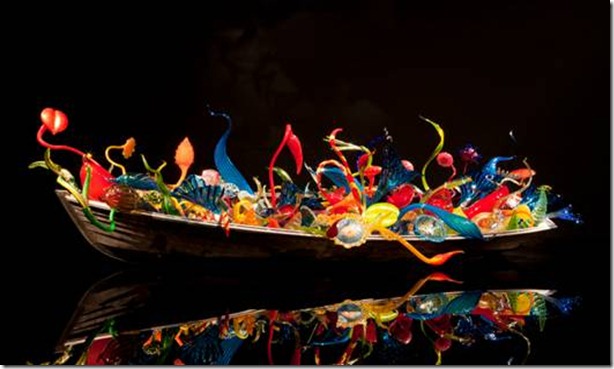We can learn about innovative leadership from Dale Chihuly. We can also see important links between innovation and collaboration by exploring his approach to his art.
Chihuly’s current exhibition, Through the Looking Glass, at the Museum of Fine Arts in Boston brings all this home.
I’ve been a Chihuly fan for twenty years, but this exhibit tops anything I’ve seen – and is a testament to how the artist has pushed the boundaries of his art and medium over his career. The Ikebana boat (below) was an Alice in Wonderland moment of pure pleasure and awe. It also spoke to the ongoing experimentation, learning from experience, passion for innovation, and teamwork at the core of Chihuly’s artistry.

The story goes that Chihuly wanted to test the strength of some glass and see it in water. So he began throwing pieces over the side of a bridge and later asked some young men to retrieve them. The image of their boats filled with shapes and color gave birth to the Ikebana concept, now a staple in his exhibitions.
Equally inspiring are the videos shown in conjunction with the exhibit. Snippets are available online. Others and interviews with the artist can be found at the video screening room on Chihuly’s website.
Take a look. Watch Chihuly in action. Hear him and others talk about the innovative power of deep teamwork. Flora Mace, who began working with Chihuly in 1975 on the Blanket Cylinders (glass pieces of different size and shape inspired by native American baskets and weaving), explains the synergy this way: “When I work for Dale, I almost become him.”
The image of the solitary artist – the solitary leader – is forever shattered by Chihuly’s high-energy, high-engagement model of leader as visionary, director, catalyst, coach, choreographer, teacher, and partner.
As Karen Chambers writes in Chihuly: Color, Glass, and Form:
“As director of the team, Chihuly makes the process a symbiotic relationship that draws on each individual’s expertise and energy. During a glassblowing session, the entire team is in sync, at one with Chihuly’s ideas and an integrated part of his creative process.
In creating the work, the team follows Chihuly’s instructions. He is like a choreographer who uses his dancers’ bodies to make tangible his ideas. Unlike teams in Europe, where production is the goal and each member has an assigned task, Chihuly’s team makes unique pieces and people exchange jobs.
While a Chihuly team works together with apparent ease, the dynamic is complex. Chihuly acts much like a film director – creating the concept, initiating the action, and setting the scene – but the process requires something else, a special chemistry in which he works as catalyst. In this role, he manages a process in constant flux, harnessing the three key elements of fire, gravity, and spontaneity.
Chihuly is the catalyst that makes it all work. He brings together the best glass blowers according to their schedules and his needs, creates the most congenial ambience [through music, food, and setting], introduces a touch of glamour by moving the sessions from site to site and flying in his team, challenges the group with his ideas, and after an intense session of work, a few distinctively Chihuly pieces emerge.”


